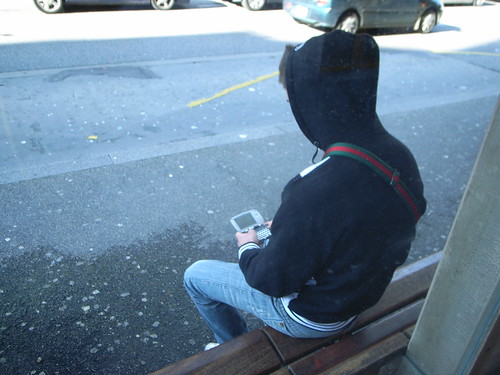Being interviewed by a French media about the state of location-based gaming, I took this opportunity as a way to frame my recent thoughts about this:

Adoption :(
An important adoption factor for social-locative games is simply... the players: lots of problems described by Dan Hon in his talk "Everything you know about ARG is wrong" can also apply to location-based games: games never have enough players, people who play are not “mainstream”, etc. Above all, the main issue with player is simply the the lack of critical mass... it's never very funny and engaging to play alone. LBGs really suffer from not reaching networks effect, a situation that Kati London in her talk at Where2.0 referred to as "The empty room effect".

Gamification, again
At the same time, it's intriguing to see that game mechanics (in general, but also the one present in early instances of location-based games) have been instrumental in the adoption of a broader category of applications: mobile social software such as Foursquare or Gowalla... which are not games per se. Having lots of discussion with people in the mobile guide/signage/urban discovery/tourism business, it's funny to see how these persons dismiss a service such as Foursquare as being only "a game". Different cultures, different perspectives :) It's also a good occasion for them to dismiss such application as not relevant for their field (to which of course I object that they're entirely wrong).
On the shoulder of "giants"
Interestingly, platforms such as Foursquare (today/tomorrow) or Facebook Places (tomorrow) could be an opportunity to develop third-party games. See for example how City Warfare has been built on top of Foursquare:
"You check into your local pub/coffee-shop/train station using FourSquare (as normal).
2) You open City Warfare in your phone’s browser.
3) You place waterballoons, shoot passers-by with your waterpistol etc.
4) While you are away, those balloons remain where you placed them and will burst when the timer runs out or you detonate them remotely.
5) The aim is to try to get as many people wet as possible. You earn credits which can be used to buy better waterbombs etc."
Location-based game genres
Concerning the challenges and purposes of these games, the types ranges from very focused goals (treasure hunts, people hunting, object collection) to less-defined goals (SCVNGR is interesting in the sense that it lets people defining the challenges). Compared to the past, location-based games have also been influenced by rampant gamification: the emphasis has been made on social comparisons (points, badges, leading boards, etc.)... and of course such games have been included in the toolbox of Media planners and digital communication agencies.
The location-based narrative/storytelling trope has never been huge BUT it less suffered from waves of interest/disillusion. Observers have noted that even standard mobile social software such as Whrrl have implemented collective location-based storytelling. And of course, platforms such as 7 Scenes also offer good possibilities for "mobile storytelling".
Besides games, there has been a surge in the development of "game engines" to enable people to create their own games. See for example what Playground (that we saw at this Lift seminar in Lyon) or Gbanga are doing.

Phones, rather than game consoles
Speaking about platforms, the de facto device for location-based games is definitely the mobile phone. Although the video game consoles such as the Nintendo DS (with games such as Treasure World) or the Sony PSP (with this Golf game), playful location-based activities are fairly limited.
In terms of technologies, the increasing number of smartphones and App stores (such as the Apple Store) have definitely eased the possibility to try and play. It's far less complicated than the past, in which we had to download weird software on Tablet PCs, PDAs and cell-phones with tiny displays + low computing power
In addition, on the sensor side, we will see an increasing use of various data beyond players' location: the usual suspects are of course the number of footsteps (and other accelerometer-based data),... plus self-declared information. Foursquare/Gowalla/Facebook Places check-in are pretty standard here but the use of pictures (taken with a camera) is also common. See for example Foodspotting (which uses "location to augment their own reality-based game").
So, what did we learn?
- Geolocation is only one kind of data that can be employed and LBG should be framed in a broader context: ARG or pervasive games. Coupled to pertinent and original forms of storytelling and game mechanics, the articulation of data such as location, pictures, SMS, tweets, or the ones generated by touch sensors (NFC on iPhone?), accelerometers, have the potential to lead to curious interactions.
- In terms of innovation, the video game industry is definitely not the right actor here. Rather digital communication agency, small interaction design boutiques and digital studio who work on interactive fictions seems more willing to push the envelope. Curiously, the new media art community has slowed down on the "locative media" meme. I have to admit that I haven't seen a lot of projects in the field in the 1-2 years (which correlated with the release of "Spook Country by William Gibson).
- I haven't mentioned Augmented Reality, I don't know what to think about AR and location-based games.
And what are the possibilities ahead?
- To avoid the empty room problem there is a need to design for single-usage, then for collective usage. We can expect platforms like these in the near future.
- Focus not only on geolocation but also other types of data. There will be games that combine the different sorts of data that can be captured or collected. Of course the most simple forms of data (self-declared such as check-ins, pictures taken with the camera) are the most likely candidate.
- Location-based games with scenarios that are too disruptive and complex for daily usage will continue to remain niches. Will people change their route to go to work in the morning? it's a bit unlikely.
- There is still some room in different urban activities: think about urban sport (skateboard, rollerblade, fixie/bike ride, parkour, etc.). The articulation of location-based games with these types of sport is an original idea that can produce good possibilities.
 Recently ran across this curious magazine called "Creative Computing", one of the earliest covering the microcomputer revolution (published from 1974 until December 1985). Readers interested in this can have a look at the some articles.
Recently ran across this curious magazine called "Creative Computing", one of the earliest covering the microcomputer revolution (published from 1974 until December 1985). Readers interested in this can have a look at the some articles.
 Two weeks ago in Basel, at the
Two weeks ago in Basel, at the 



 A French Keyboard with stickers showing letters from the cyrillic alphabet, used by one of my students. Interestingly, some of them are absent on letters such as A, E, R, T... which corresponds to the ones most often used in French (I don't know why Z is in there...)
A French Keyboard with stickers showing letters from the cyrillic alphabet, used by one of my students. Interestingly, some of them are absent on letters such as A, E, R, T... which corresponds to the ones most often used in French (I don't know why Z is in there...)



 Last Saturday, Julian and I gave a quick and punchy workshop called
Last Saturday, Julian and I gave a quick and punchy workshop called  What's better than a broken iPhone screen in a workshop about accidents and failures?
What's better than a broken iPhone screen in a workshop about accidents and failures?


 Seen yesterday in a Swiss train. Digital device to iPhone interaction for visual marker recognition. Yet another curious situation to observe in the train (after train sensors) because there are sometimes some problems for the system to read the 2D code. As usual with new forms of interactions, it leads to lively discussion with the other passengers (who have their own stories about the problems caused by this).
Seen yesterday in a Swiss train. Digital device to iPhone interaction for visual marker recognition. Yet another curious situation to observe in the train (after train sensors) because there are sometimes some problems for the system to read the 2D code. As usual with new forms of interactions, it leads to lively discussion with the other passengers (who have their own stories about the problems caused by this).
 A map of Zelda found at
A map of Zelda found at  A map of Loco Roco found at
A map of Loco Roco found at  The density of information on the back of a Polaroid camera, observed at the flea market in Geneva.
The density of information on the back of a Polaroid camera, observed at the flea market in Geneva. As claimed by Fredrik Pohl "A good science fiction story should be able to predict not the automobile but the traffic jam". Just thought it would be good to play with a LOLtechnology such as
As claimed by Fredrik Pohl "A good science fiction story should be able to predict not the automobile but the traffic jam". Just thought it would be good to play with a LOLtechnology such as 
 A voting interface encountered last week in Lyon at the local city council. It's interesting to note:
A voting interface encountered last week in Lyon at the local city council. It's interesting to note: Seen in Marseille, France last week-end. An interesting occurrence of very close proximity between a human being and his cell-phone. Various remarks here:
Seen in Marseille, France last week-end. An interesting occurrence of very close proximity between a human being and his cell-phone. Various remarks here: For those who read the
For those who read the